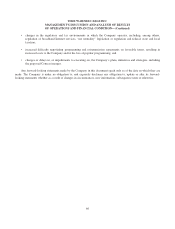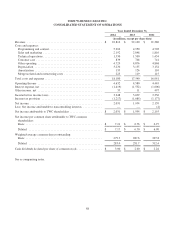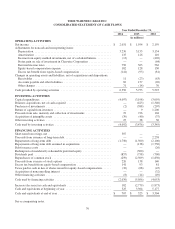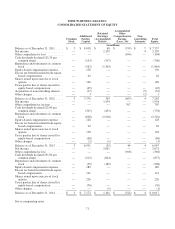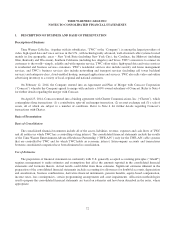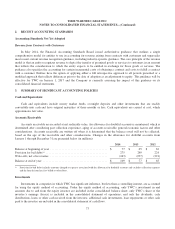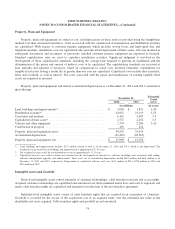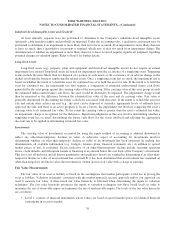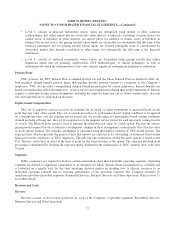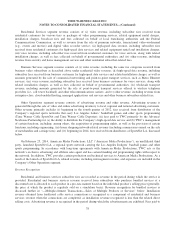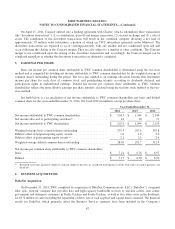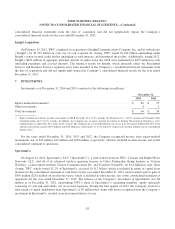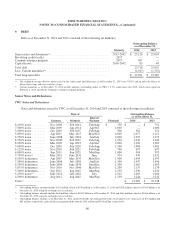Time Warner Cable 2014 Annual Report Download - page 84
Download and view the complete annual report
Please find page 84 of the 2014 Time Warner Cable annual report below. You can navigate through the pages in the report by either clicking on the pages listed below, or by using the keyword search tool below to find specific information within the annual report.TIME WARNER CABLE INC.
NOTES TO CONSOLIDATED FINANCIAL STATEMENTS—(Continued)
Indefinite-lived Intangible Assets and Goodwill
At least annually, separate tests are performed to determine if the Company’s indefinite-lived intangible assets
(primarily cable franchise rights) and goodwill are impaired. Under the accounting rules, a qualitative assessment may be
performed to determine if an impairment is more likely than not to have occurred. If an impairment is more likely than not
to have occurred, then a quantitative assessment is required, which may or may not result in an impairment charge. The
determination of whether an impairment is more likely than not to have occurred requires significant judgment regarding
potential changes in valuation inputs. Refer to Note 8 for further details.
Long-lived Assets
Long-lived assets (e.g., property, plant and equipment and finite-lived intangible assets) do not require an annual
impairment test; instead, long-lived assets are tested for impairment upon the occurrence of a triggering event. Triggering
events include the more likely than not disposal of a portion of such assets or the occurrence of an adverse change in the
market involving the business employing the related assets. Once a triggering event has occurred, the impairment test is
based on whether the intent is to hold the asset for continued use or to hold the asset for sale. If the intent is to hold the
asset for continued use, the impairment test first requires a comparison of estimated undiscounted future cash flows
generated by the asset group against the carrying value of the asset group. If the carrying value of the asset group exceeds
the estimated undiscounted future cash flows, the asset would be deemed to be impaired. The impairment charge would
then be measured as the difference between the estimated fair value of the asset and its carrying value. Fair value is
generally determined by discounting the future cash flows associated with that asset. If the intent is to hold the asset for
sale and certain other criteria are met (e.g., the asset can be disposed of currently, appropriate levels of authority have
approved the sale, and there is an active program to locate a buyer), the impairment test involves comparing the asset’s
carrying value to its estimated fair value. To the extent the carrying value is greater than the asset’s estimated fair value,
an impairment charge is recognized for the difference. Significant judgments in this area involve determining whether a
triggering event has occurred, determining the future cash flows for the assets involved and selecting the appropriate
discount rate to be applied in determining estimated fair value.
Investments
The carrying value of investments accounted for using the equity method of accounting is adjusted downward to
reflect any other-than-temporary declines in value. A subjective aspect of accounting for investments involves
determining whether an other-than-temporary decline in value of an investment has been sustained. In making this
determination, all available information (e.g., budgets, business plans, financial statements, etc.) in addition to quoted
market prices, if any, is evaluated. Factors indicative of an other-than-temporary decline include recurring operating
losses, credit defaults and subsequent rounds of financing at an amount below the cost basis of the Company’s investment.
This list is not all-inclusive and all known quantitative and qualitative factors are weighed in determining if an other-than-
temporary decline in value of an investment has occurred. If it has been determined that an investment has sustained an
other-than-temporary decline in value, the investment is written down to fair value with a charge to earnings.
Fair Value Measurements
The fair value of an asset or liability is based on the assumptions that market participants would use in pricing the
asset or liability. Valuation techniques consistent with the market approach, income approach and/or cost approach are
used to measure fair value. A three-tiered fair value hierarchy is followed when determining the inputs to valuation
techniques. The fair value hierarchy prioritizes the inputs to valuation techniques into three broad levels in order to
maximize the use of observable inputs and minimize the use of unobservable inputs. The levels of the fair value hierarchy
are as follows:
• Level 1: consists of financial instruments whose values are based on quoted market prices for identical financial
instruments in an active market.
76


